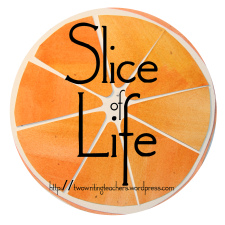 I am participating in #SOL Tuesdays.
I am participating in #SOL Tuesdays.
Story in a Bag is an engaging way to help students write a narrative by embedding a series of objects into their story in a way that makes good sense. This activity helps students build writing fluency, and at the same time, it helps them learn to problem solve on the spot! As items are removed from the bag, the writers must somehow weave them seamlessly into the story. At times, this can be very challenging!
To model Story in a Bag, the teacher fills a paper bag with 5-8 random objects. To make this activity interesting, the objects should be diverse and unrelated to each other. Go for a combination of the unusual and the mundane. These items are used to help bring the story to life. I usually start with items that are themed around a subgenre of fiction such as mystery, adventure, fantasy, or science fiction. It is great to pair your Story in a Bag with a subgenre you have just explored in reading or writing workshop. An adventure story bag could include a journal, a map, a picture of a secret passageway, a card that reads “DANGER!”, a shovel, and a tiny box or chest. I always write a lead sentence on the board to get everybody writing. You could use “It was a dark and stormy night!” or “It was very early for our doorbell to ring, and when I opened the door – no one was there.” Students can choose to revise their lead sentence after the story is completed or they can keep the original.
When I model, I usually create the story through oral rehearsal since writing it may take too much time. As I pull items from the bag, I lay the item on a large table where all the students can see them. This helps writers catch up if they are a little behind since they will always have a visual representation of the order of the items in plain view. Later, I may write the story as I remember telling it. It is important to note that you could choose to record yourself on an audio device such as RecForge Pro, an app of choice for many that includes cloud integration, multiple formats, editing, adjustable quality levels, playback speed adjustments, and more. For teachers, audio recording logistics are simple and easy to adapt with an iPad or any device with a recording app. You and/or your students can upload the recording to a Google Drive folder, email the file to students or to the teacher, or save it on the course management system.
Sometimes, you can scaffold a story in the bag by placing words or phrases on sentence strips and pulling them from your bag in a meaningful order. For example, consider the following list:
Sammy’s kitten 
The park
A big dog 
A tall tree 
Too frightened to meow
The fire department
A long ladder
A bowl of milk
You could also include some props or create them such as this sign:

It is fun to see what everyone comes up with and how they find a way to incorporate all the objects and end their individual story. After you model one or two Story in a Bag sessions, encourage your students to create their own Story in a Bag individually or with a partner to lead the writing session. With my fourth graders, we saved this activity for the last Friday of each month. The class created and posted a sign-up sheet, and we often had a partnership or a group of three collaborating to create their bag of items. Enjoy!